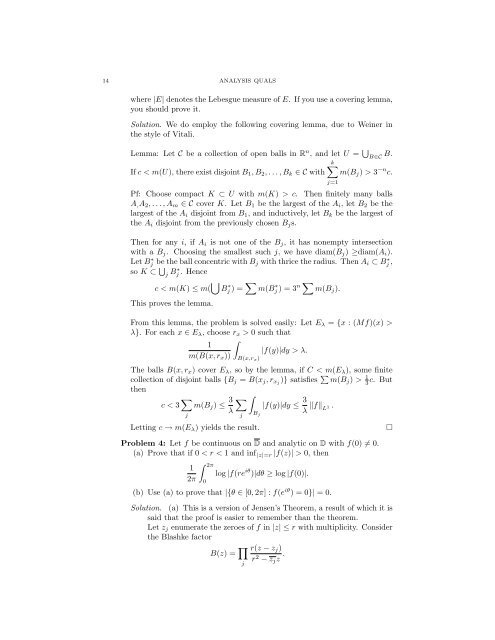ANALYSIS QUALIFYING EXAM PROBLEMS BRIAN LEARY ...
ANALYSIS QUALIFYING EXAM PROBLEMS BRIAN LEARY ...
ANALYSIS QUALIFYING EXAM PROBLEMS BRIAN LEARY ...
You also want an ePaper? Increase the reach of your titles
YUMPU automatically turns print PDFs into web optimized ePapers that Google loves.
14 <strong>ANALYSIS</strong> QUALS<br />
where |E| denotes the Lebesgue measure of E. If you use a covering lemma,<br />
you should prove it.<br />
Solution. We do employ the following covering lemma, due to Weiner in<br />
the style of Vitali.<br />
Lemma: Let C be a collection of open balls in Rn , and let U = <br />
B∈C B.<br />
k<br />
If c < m(U), there exist disjoint B1, B2, . . . , Bk ∈ C with m(Bj) > 3 −n c.<br />
Pf: Choose compact K ⊂ U with m(K) > c. Then finitely many balls<br />
A,A2, . . . , Am ∈ C cover K. Let B1 be the largest of the Ai, let B2 be the<br />
largest of the Ai disjoint from B1, and inductively, let Bk be the largest of<br />
the Ai disjoint from the previously chosen Bjs.<br />
Then for any i, if Ai is not one of the Bj, it has nonempty intersection<br />
with a Bj. Choosing the smallest such j, we have diam(Bj) ≥diam(Ai).<br />
Let B ∗ j be the ball concentric with Bj with thrice the radius. Then Ai ⊂ B ∗ j ,<br />
so K ⊂ <br />
j B∗ j . Hence<br />
j=1<br />
c < m(K) ≤ m( B ∗ j ) = m(B ∗ j ) = 3 n m(Bj).<br />
This proves the lemma.<br />
From this lemma, the problem is solved easily: Let Eλ = {x : (Mf)(x) ><br />
λ}. For each x ∈ Eλ, choose rx > 0 such that<br />
<br />
1<br />
|f(y)|dy > λ.<br />
m(B(x, rx))<br />
j<br />
B(x,rx)<br />
The balls B(x, rx) cover Eλ, so by the lemma, if C < m(Eλ), some finite<br />
collection of disjoint balls {Bj = B(xj, rxj )} satisfies m(Bj) > 1<br />
3c. But<br />
then<br />
c < 3 <br />
m(Bj) ≤ 3 <br />
<br />
|f(y)|dy ≤<br />
λ<br />
3<br />
λ fL1 .<br />
j<br />
Bj<br />
Letting c → m(Eλ) yields the result. <br />
Problem 4: Let f be continuous on D and analytic on D with f(0) = 0.<br />
(a) Prove that if 0 < r < 1 and inf |z|=r |f(z)| > 0, then<br />
1<br />
2π<br />
2π<br />
0<br />
log |f(re iθ )|dθ ≥ log |f(0)|.<br />
(b) Use (a) to prove that |{θ ∈ [0, 2π] : f(e iθ ) = 0}| = 0.<br />
Solution. (a) This is a version of Jensen’s Theorem, a result of which it is<br />
said that the proof is easier to remember than the theorem.<br />
Let zj enumerate the zeroes of f in |z| ≤ r with multiplicity. Consider<br />
the Blashke factor<br />
B(z) = r(z − zj)<br />
r2 − zjz .<br />
j
















